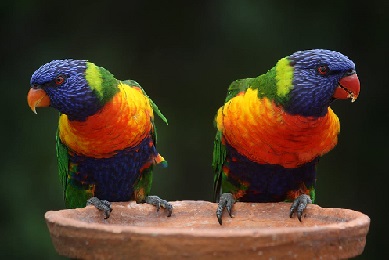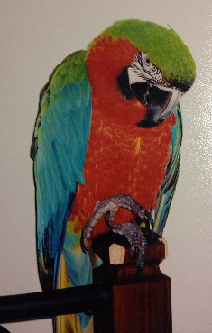Birds as Pets
 If you're considering getting a bird for a pet, do your homework first and see if you're ready for what can be a long-term commitment when caring for these wonderful creatures. It's also a good idea to speak with a veterinarian prior to bringing your pet bird home. The first stop on the way home should be at the vet's office to get a checkup and any special care instructions you will need for the species you choose.
If you're considering getting a bird for a pet, do your homework first and see if you're ready for what can be a long-term commitment when caring for these wonderful creatures. It's also a good idea to speak with a veterinarian prior to bringing your pet bird home. The first stop on the way home should be at the vet's office to get a checkup and any special care instructions you will need for the species you choose.
Setting up the Cage
When choosing where to set up your bird's cage, the Association of Avian Veterinarians (AAV) recommends placing it in an area of high-activity in your home. This helps not only keep your pet bird entertained mentally but also helps keep the bird more tame. Be sure the cage is not in direct sunlight or in areas that undergo extreme temperature changes such as near exterior doors. Get the biggest cage you have room for in your home, look for sturdy and nontoxic construction, and remember too that some species like hiding spots, somewhere inside the cage the bird can go for privacy.
Your pet bird will need perches and depending on the species you choose, you may need more than one. For example, finches enjoy hopping from one perch to another. Place the perches so that droppings fall onto an area of the cage floor that can be cleaned easily, such as onto newspapers or other material that you will need to replace daily. A quick cleanup daily and a thorough weekly cleaning of the cage are recommended to keep water and food containers free of debris and prevent a build-up of bacteria inside the cage.
Food and Water
Of course, you will also need proper containers for food and water, with "proper" meaning something that cannot be constantly turned on end by the bird. Look for shallow wide bowls with heavy well-built bases and place the food and water bowls on different ends of the cage to encourage your bird to move around more. This also helps keep food out of the water bowl and vice versa.
When choosing food for your pet bird, it is best to do a bit of research on the particular species you choose. Commercial foods made for specific species typically work well. If you have doubts about the proper diet for your pet bird, be sure and consult a veterinarian or nutritionist, as a proper diet is essential for good health.
Grooming
Expect your pet bird to groom regularly. During molting, a natural process when old feathers are replaced with new ones, the grooming behaviors may include picking at his feathers. This is normal.
You will need to provide regular bathing for your pet bird; some species need this daily. Consider a bathing dish inside the cage or bathe your bird in a bathroom sink, using mild shampoo, such as one made for human babies, and be sure to rinse thoroughly. If your bird obviously does not enjoy this routine, the AAV recommends daily misting with clean warm water to help him groom. Spray lightly until his feathers are damp.
You may need to help your feathered companion trim his nails. If you do not feel confident in completely this grooming procedure, seek the help of a professional.
Exercise and Toys
 Some birds, such as the Lorikeet Rainbow Parrot, two which are pictured at right, need three to four hours flying time outside of the cage daily. You might opt for a species that needs this flying time, if so allow your bird to fly freely in a larger area of your home. If you do choose this option, always remain aware of hindrances such as moving ceiling fans and hanging light fixtures. Also, cover large windows if your bird is out of his cage, as he may not be able to see the glass. Be aware of opening and closing doors during this flying time too. For some birds, it's best not to allow time outside the cage as it can require a marathon effort to get him or her back in. Speak with a professional before bringing your pet bird home about what is best for the species you choose.
Some birds, such as the Lorikeet Rainbow Parrot, two which are pictured at right, need three to four hours flying time outside of the cage daily. You might opt for a species that needs this flying time, if so allow your bird to fly freely in a larger area of your home. If you do choose this option, always remain aware of hindrances such as moving ceiling fans and hanging light fixtures. Also, cover large windows if your bird is out of his cage, as he may not be able to see the glass. Be aware of opening and closing doors during this flying time too. For some birds, it's best not to allow time outside the cage as it can require a marathon effort to get him or her back in. Speak with a professional before bringing your pet bird home about what is best for the species you choose.
All pet birds need toys to enhance both mental and physical exercise inside the cage. Natural items like small twigs from trees and pinecones work well, according to the AAV. The AAV also recommends simple items like dried corn on the cob or a cardboard toilet paper or paper towel roller for your bird to tear apart. And yes, there will be a mess. Birds can be quite the messy pets, but it's great fun to watch them play.
Whether or not your pet bird has messy toys, he will scatter food, dropping a good portion to the bottom of the cage and somehow managing to scatter it around the area outside of the cage, regardless of where his food bowl is placed. Be prepared to clean often.
In addition to toys and playtime, some bird species need human interaction for several hours a day to remain tame. Consider this before taking on the long-term commitment of a pet bird owner.
A Personal Note about Pet Birds
 My feathered client, Crosby, pictured at left, is a beautiful bird, a Harlequin Macaw. A Harlequin Macaw is a hybrid cross between the Blue and Gold Macaw and the Greenwing Macaw, both of which are Neotropical parrots native to South America. Harlequin Macaws can live to be more than 70 years old.
My feathered client, Crosby, pictured at left, is a beautiful bird, a Harlequin Macaw. A Harlequin Macaw is a hybrid cross between the Blue and Gold Macaw and the Greenwing Macaw, both of which are Neotropical parrots native to South America. Harlequin Macaws can live to be more than 70 years old.
Crosby is probably 18 inches tall and has quite the personality. Once when I was caring for him and his feline house mates, I was downstairs cleaning litter boxes and I heard him saying "peek-a-boo." The way he says the word it is quite eerie if you're not looking directly at him. He draws it out as in peeeeek-aaaaahhh-booooooo. I love it.
Another feathered client I take care of on a regular basis seems to enjoy me singing to him. When I sing, he dances. He is a small parrot and talks occasionally. According to his owner he is almost 21 years old. He can say hello in both English and Spanish and my favorite is when he says "Step up, step up, step up." I try to get him to tell me he loves me, he says this to his owner, but he won't tell me when I'm taking care of him. Go figure.
Additional Considerations BEFORE Getting a Bird
A bird is not an ideal pet for everyone. For example, without training don't plan on taking your pet bird out of its cage and playing games with him. Chances are you'll get bitten. This is not a malicious action. A bird will bite when he feels threatened and also because that just what birds do, he uses his beak to hold on to things and that will include you. In addition, for this reason and others, birds are not ideal pets for young children. Natural curiosity pushes us little humans to touch, hold and squeeze.
Plan on your bird making a lot of noise. Whether or not you choose a species who talks, many birds love to sing. Not all birds are loudly vocal but some are and it's difficult to know for sure how an individual bird will act until it's settled into its new environment.
On a personal note, considering my feathered clients who talk, I'm in their home and only for short intervals multiple times a day, so it's quite a treat when I get to hear them talk.
Before bringing a bird home as a pet, consider its life expectancy and determine if you're committed for the long term. For example, some Macaw species can live for 80 years or more and many other types of parrots live to be 30 or 40 or more.
As always, if you have questions or need information about your pet's care, ask a vet.
A Good Resource for Pet Bird Owners: Association of Avian Veterinarians
